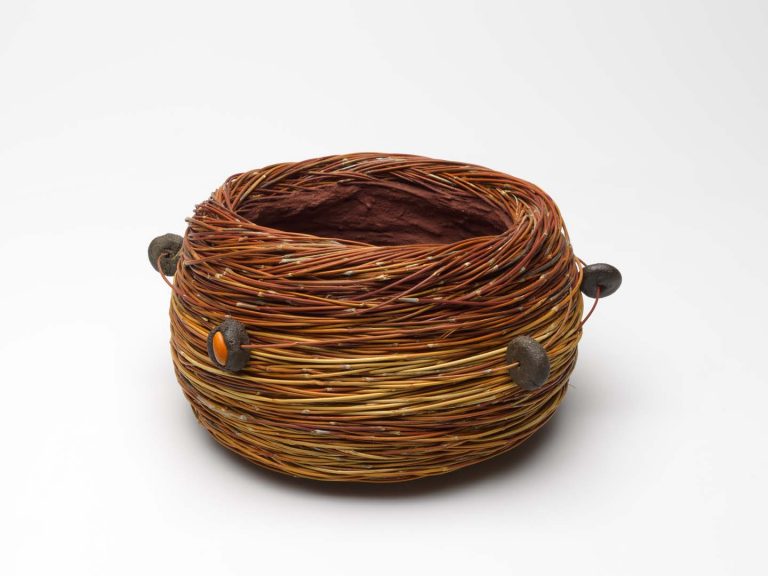We acknowledge the Traditional Owners of the land on which the Queensland Art Gallery | Gallery of Modern Art stands and recognise the creative contribution First Australians make to the art and culture of this country.

Shirley Macnamara / Indjalandji/Alyawarr / Australia b.1949 / Spinifex vessel I 2011 / Twined spinifex (Triodia pungens), ochre, seeds, spinifex resin and synthetic polymer fixative / 12 x 27cm (diam.) / Purchased 2011. Queensland Art Gallery Foundation Grant / Collection: Queensland Art Gallery | Gallery of Modern Art / © The artist
Shirley MacnamaraSpinifex vessel I 2011
Not Currently on Display
Dense spinifex hummocks grow abundantly in the parched ground of western Queensland where Shirley Macnamara lives. In them, the artist finds shelters made by small animals and insects, and Spinifex vessel I is reminiscent of those forms.
Macnamara has a deep reverence for the natural world; when harvesting her materials, she avoids destroying spinifex plants unnecessarily by carefully taking only the stolons – the runner roots that connect individual hummocks. After selecting the fine strands to use, she strips off their dull outer casings to reveal the yellows, golds and reds that first attracted her to the plant. Its colours vary by season, intensifying in the summer heat and becoming paler after the rain.
Macnamara relishes tactility. To explore this quality, she has pasted crushed ochres — wamarla (red) or guthulu (yellow) ochre — and black spinifex resin into the fabric of finished pieces, as well as embedding or scattering small objects over their surfaces.
Shirley Macnamara runs a thriving cattle property with her son and his family near Mount Isa in western Queensland. She has close ties with Camooweal and the surrounding country through her mother’s Indjalandji people, and with Alyawarr lands, particularly Lake Nash, through her father.
Macnamara started painting in 1987, but began to experiment with weaving in 1992. She is well known for the guutu (vessels) she makes using combinations of synthetic and natural materials. In particular, she likes to work with spinifex (Triodia pungens), a tough, spikey native grass commonly found in the driest parts of Australia.
Spinifex’s long roots help keep the soil together so that the sand does not spread and create more desert. For Macnamara, spinifex embodies strength and utility, and she uses it to create tactile sculptures that reflect her surroundings, culture and history, as well as personal experiences and memories.
Discussion Questions
1. Spinifex vessel I resembles a nest or small shelter. What sort of animal or insect do you think might live here?
Classroom Activities
Trace and cut a template for a basket out of lightweight cardboard. Weave together different materials such as paper, cardboard, fabric, cane or raffia to form a basket. Experiment with texture by adding objects to the outside of the basket.